
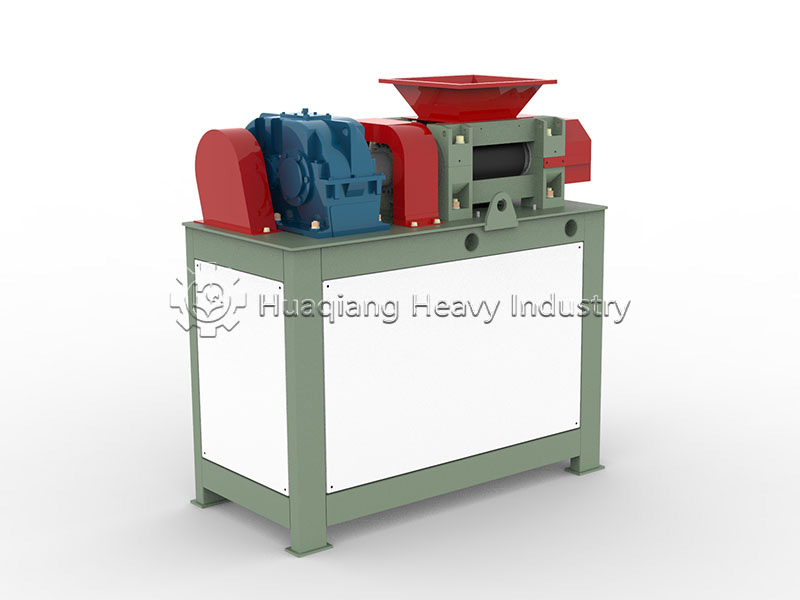

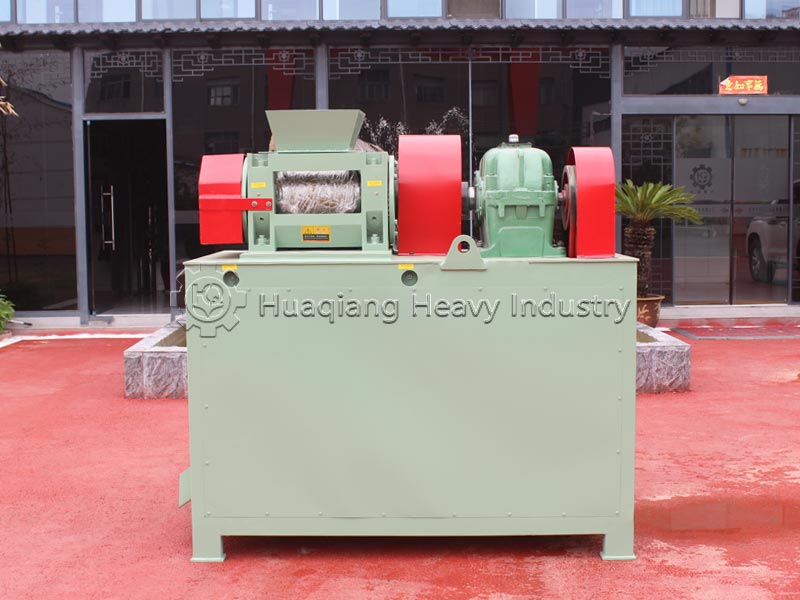

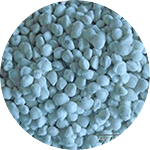
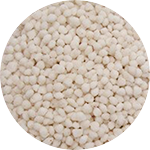
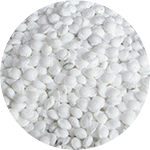
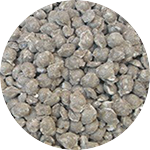
Where are double roller granulators commonly used?
The double roller granulator has a unique working principle and structural design, and its adaptability to raw materials is extremely wide. It has outstanding performance in many fields. The specific application scenarios are as follows:
1.Fertilizer field
It is capable of producing various types of compound fertilizers with various concentrations (from low concentration of 20% to high concentration of more than 60%), such as the granulation of single fertilizers such as ammonium chloride and ammonium sulfate, as well as the production of compound fertilizers such as organic fertilizers, inorganic fertilizers, biological fertilizers, and magnetic fertilizers.
The technology has significant advantages in granulating rare earth, potash, and ammonium bicarbonate compound fertilizers. For example, it effectively addresses the moisture absorption and caking issues associated with traditional potash granulation methods, resulting in granular potash fertilizers with excellent fluidity and low hygroscopicity. This technology fills a gap in related fields in China and is at the forefront domestically.
It can also use ammonium carbon, urea, ammonium chloride, ammonium phosphate, potassium chloride, etc. as base materials to produce multi-element fertilizers with different proportions of nitrogen, phosphorus and potassium according to different soil fertility and crop needs, to meet the diverse nutrient needs of different crops such as rice, wheat, corn, vegetables and fruits.
2.Other industrial fields
Pharmaceutical industry: Suitable for granulation of various medicinal granules, such as Chinese medicine granules, raw material granules of Western medicine tablets, etc. The granulation process can effectively ensure the stability and uniformity of drug ingredients.
Chemical industry: It can be used for granulation of capsule filling particles, pigments (such as titanium dioxide particles), detergents (such as washing powder particles), catalysts (such as automobile exhaust catalyst particles), strontium carbonate, inorganic salts (such as sodium chloride particles), chloroisocyanuric acid, bleaching powder, pesticides (such as insecticide particles), oxides and other materials.
Feed industry: It can mix various feed raw materials, such as corn, soybean meal, fish meal, etc., and then extrude and granulate them to produce nutritionally balanced pellet feed that is easy to store and transport, reducing feed waste during transportation and feeding.
Industrial dust recovery: It also plays an important role in industrial dust recovery. For example, the dust from iron foundries contains a large amount of iron. These dust materials can be compressed and formed by mechanical pressure through the roller extrusion granulator without adding any wetting agent, thus ensuring the purity of the product. The formed particles can be reused in ironmaking production. Lead, zinc, aluminum dust, converter dust, filter dust, grinding dust and other dust can also be effectively recycled, which not only reduces environmental pollution but also improves resource utilization.
How is the double roller granulator designed according to the granulation process?
The double roller granulator consists of several key parts working together. The structure and function of each part are as follows:
1.Feeding device
Usually consists of a hopper, screw conveyor or belt conveyor. The hopper is used to temporarily store mixed materials. Its capacity depends on the production scale and can generally hold 1-5 cubic meters of materials.
A screw conveyor or belt conveyor is responsible for smoothly and quantitatively transporting the material from the hopper to the extrusion rollers. Its conveying speed can be adjusted by a variable frequency motor to ensure a stable material supply and lay the foundation for the smooth progress of the subsequent extrusion process. During the conveying process, sensors installed on the feed device can also monitor the material flow in real time, enabling automatic adjustment.
As the core component of the equipment, the extrusion roller is usually made of high-strength alloy steel, such as 45 steel, chrome-molybdenum steel, etc. After tempering, quenching and other heat treatment processes, the surface hardness can reach HRC50-60, and it has good wear resistance and pressure resistance.
The surface is typically designed with regularly arranged grooves, holes, or protrusions of uniform shape and size. The grooves can be circular, square, or diamond-shaped, with a depth of 2-10 mm and a spacing of 5-20 mm. These special designs optimize the extrusion of the material, allowing it to be better shaped during the extrusion process, producing pellets that meet specific shapes and specifications.
2.Discharging device
It is generally composed of an inclined chute and a conveyor belt. The chute is usually made of stainless steel to prevent material adhesion and corrosion.
3.Transmission and control systems
The transmission system is driven by an electric motor (usually a three-phase asynchronous motor, with a power ranging from 5.5kW to 55kW depending on the equipment model) to drive the belt and pulley, which is transmitted to the driving shaft through a reducer (commonly used gear reducers, cycloid pinwheel reducers, etc.), and synchronized with the driven shaft through split gears, so that the two extrusion rollers work in opposite directions. The speed can generally be adjusted within the range of 10-50 rpm.
The control system, comprised of a PLC control cabinet, touch screen, and sensors, precisely regulates equipment operating parameters such as speed, extrusion pressure, and material flow. Operators set these parameters via the touch screen, and the system automatically adjusts based on sensor feedback to meet the needs of different materials and production processes, ensuring stable and efficient operation.
How does the roller extrusion granulator make fertilizer?
The granulation process of the double roller granulator is a systematic process. Each link has an important impact on the quality of the final product. The specific steps are as follows:
Storage, metering, mixing
First, various raw materials are stored in different storage silos. The storage silos usually adopt steel or concrete structures, which have good sealing and moisture-proof properties to prevent the raw materials from absorbing moisture and deteriorating.
For complex formulas like compound fertilizers, intermittent mixing is often employed. Metered raw materials are placed in a mixer (such as a twin-shaft paddle mixer or conical mixer) for a typical mixing time of 5-15 minutes. Professional mixing equipment ensures thorough mixing to evenly distribute the components and ensure consistent product quality. The moisture content of the mixed material should be controlled between 5% and 15% to meet the requirements of subsequent extrusion granulation.
Extrusion molding: The uniformly mixed material is fed through a feeder into the space between the rollers of a double roller granulator. Under the powerful extrusion pressure (adjustable between 5-30 MPa depending on the material's characteristics), the material density increases significantly, transforming from a loose powder or granular form into a dense sheet or strip. The density can be increased from an initial 0.5-0.8 g/cm³to 1.2-1.8 g/cm³, completing the initial molding process.
During the extrusion process, the speed and extrusion pressure of the extrusion roller need to be adjusted in real time according to the characteristics of the material to ensure the forming effect.
Crushing, screening and extrusion of flake or strip materials need to enter the crusher (such as cage crusher, hammer crusher, etc.) for crushing. The speed of the crusher is generally 800-1500 rpm, which breaks them into particles of relatively uniform size. The particle diameter is usually between 1-6 mm.
The fertilizer pellets are then filtered through screening equipment (such as a vibrating screen) according to preset particle size standards to select the granular fertilizers that meet the requirements. The mesh size of the screening equipment is determined by the desired particle size, generally ranging from 8 to 40 mesh. The fine powder produced during the screening process (typically accounting for 10%-20% of the total output) can be recycled back to the mixing process through a circulation system for reuse, improving raw material utilization and reducing production costs.
Finishing: The sieved particles are further trimmed, usually using equipment such as a polishing machine or a rounding machine to round the edges and corners of the particles to make them more round and regular.
This not only improves the appearance quality of the product, makes the particles more regular and beautiful, and enhances the competitiveness of the product in the market, but also reduces the wear of the particles during storage and transportation.
What are the characteristics and advantages of the double roller granulator in the fertilizer production process?
Compared with other granulation equipment, the double roller granulator has the following advantages:
1.Energy saving and consumption reduction
As mentioned above, the high energy consumption of the drying process in wet granulation is avoided, which greatly reduces energy consumption. Taking a compound fertilizer production line with an annual output of 10,000 tons as an example, the use of a double roller granulator can save 100-200 tons of standard coal per year.
2.Environmental advantages
The absence of a drying process also avoids pollution problems such as waste gas emissions caused by drying, and there is no need to equip complex waste gas treatment equipment.
3.Simple process
The process is short and simple, and only a few main steps are required from raw material mixing to the production of finished particles, without the need for complex intermediate steps such as drying and cooling.
4.High product quality
The produced particles have high strength, generally reaching 20-50N, and the bulk density is significantly improved, usually 50%-100% higher than the raw materials. They can better meet the requirements of the product during storage, transportation and use, and reduce particle breakage and agglomeration.
5.Great operational flexibility
The size of the extrusion force can be flexibly adjusted by hydraulic pressure, with a wide adjustment range, which can adapt to different material properties (such as material hardness, humidity, viscosity, etc.) and production process requirements.
What are the benefits of using a double roller extrusion granulator to make fertilizer?
Using a double roller extrusion granulator to make fertilizer has many significant benefits, as follows:
1.Improve fertilizer utilization
The fertilizer granules produced by the roller extrusion granulator have regular shapes and uniform particle sizes. They can be distributed more evenly in the soil and have a moderate contact area with the soil.
2.Convenient fertilization operation
Compared with powdered fertilizer, granular fertilizer has better fluidity and is easier to mechanize during the fertilization process. For example, precise fertilization can be carried out using equipment such as seeders and fertilizer spreaders. The amount and location of fertilizer can be accurately controlled based on parameters such as row spacing and plant spacing of crops.
3.Improve the physical properties of fertilizers
The granulated fertilizer has high particle strength and appropriate bulk density. It is not easy to break or clump during storage. It has good storage stability and can be stored for 6-12 months without obvious deterioration.
4.Meet the needs of different crops
It is capable of producing various types of compound fertilizers and can flexibly adjust the formula according to the needs of different crops for nitrogen, phosphorus, potassium and other trace elements at different growth stages.
How to properly perform regular maintenance on the double roller granulator?
In order to ensure the normal operation of the double roller extrusion granulator and extend its service life, the following maintenance work needs to be done:
1.Regular inspection of components
Before starting the machine every day, check whether the hopper of the feeding device is blocked, whether the transmission part of the screw conveyor or belt conveyor is normal, and whether there is any abnormal noise.
Check the grooves, holes or protrusions on the surface of the extrusion roller every week for wear and deformation. If the wear depth of the grooves on the surface of the extrusion roller is found to be more than 1 mm, it should be repaired or replaced in time.
Check the chute of the discharging device every month for wear and corrosion, and check whether the tension of the conveyor belt is appropriate and whether there is any deviation.
Check each component of the transmission and control system every quarter, such as the tightness of the belt, the meshing condition of the gears, the temperature of the bearings (the normal temperature should not exceed 70°C), etc., to check for wear, looseness, deformation, etc., and make timely adjustments and repairs to ensure the normal operation of the equipment and product quality.
2.Keep your equipment clean
After each production, clean the residual materials on the surface and inside of the equipment in time. You can use compressed air blowing, clean water flushing (for water-insoluble materials), etc.
Especially between the production of different types of materials, the equipment must be thoroughly cleaned. For example, when changing the type of fertilizer, the feeding device, extrusion roller, discharge device and other parts that come into contact with the material must be thoroughly cleaned to avoid cross-contamination of materials and affect product quality.
3.Lubrication maintenance
For the transmission parts of the equipment, such as reducers, gears, bearings, etc., lubricating oil (grease) should be added or replaced regularly according to the requirements of the equipment instruction manual.
Reducer gear oil should generally be replaced every 1,000 hours of operation, and bearing grease should be added every 500 hours. When adding lubricant (grease), pay attention to the type and amount of oil (grease) to ensure smooth operation of the transmission system, reduce component wear, and extend the service life of the equipment.
4.Adjust the gap between the rollers
During the production process, the roller gap may need to be adjusted based on output or material characteristics. This adjustment must be performed strictly in accordance with the operating procedures. First, stop the machine, cut off the power supply, remove the glands at both ends of the passive shaft, and rotate the two eccentric sleeves in the same direction, adjusting one position at a time (approximately 1°-2°).
After adjustment, manually rotate the extrusion rollers to check for collisions between the two rollers. The gap should be kept between 0.3-1mm. After adjustment, reinstall the pressure cap, start the machine for a test run, and observe the pellet forming effect. If it does not meet the requirements, adjust again.
5.Ball and socket alignment adjustment
The ball socket is formed by the concave grooves on the main roller surface, which may cause axial and circumferential alignment problems. Axial alignment is adjusted during installation and generally does not require frequent adjustment. If adjustment is required, tighten or loosen the glands on both sides of the passive bearing seat to push the eccentric sleeve to move in accordance with the active roller. During the adjustment process, use a dial indicator to monitor the axial displacement to ensure alignment accuracy.
To adjust the circumferential alignment, loosen the six bolts connecting the driven gear and the adjustment sleeve, slightly disengaging the sleeve and the driven gear. Use the two included adjustment bolts to adjust the misalignment. Each adjustment should be minimal (approximately 0.5°-1°). Alignment can be assessed by placing a cardboard sheet between the two rollers and observing the traces left after rolling until the ball and socket are fully aligned. Once adjustment is complete, tighten the connecting bolts.
| Model | DZJ-I 1.0 | DZJ-I 2.0 | DZJ-I 3.0 | DZJ-I 3.0 |
| Capacity (t/h) | 1-1.5 | 1.5-2.5 | 2-3 | 3-4 |
| Power (Kw) | 11 | 18.5 | 22 | 45 |
| Roller Dimension(mm) | ø150x220 | ø150x300 | ø186x300 | ø300x300 |
| Feed Material Size(mm) | <=0.5 | <=0.5 | <=0.5 | <=0.5 |
| Output Granules Size(mm) | ø2.5-ø10 | ø2.5-ø10 | ø2.5-ø10 | ø2.5-ø10 |
| Gearbox Model | ZLY-160 | ZLY-160 | ZLY-180 | ZLY-224 |
| Rotation Speed (r/min) | 60 | 60 | 60 | 60 |